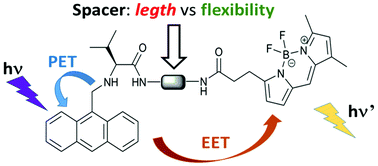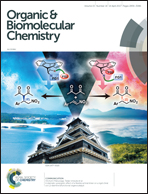Novel fluorescent anthracene–bodipy dyads displaying sensitivity to pH and turn-on behaviour towards Cu(ii) ions†
Abstract
Three bichromophoric compounds containing anthracene and bodipy moieties connected by different spacers have been synthesized and fully characterized. The set of spacers comprises a variety of bridges (short and flexible 1,2-diaminoethane in compound 1a, long and flexible 1,8-diaminooctane in compound 1b and short and rigid piperazine in compound 1c). The new compounds show interchromophoric communication via Electronic Energy Transfer (EET). When anthracene is excited, the energy is efficiently transferred to the bodipy moiety. The emission of the acceptor is partially quenched in dyad 1a but remarkably not in 1b and 1c. In an aqueous environment, the fluorescence of the new compounds display sensitivity to pH (emissive at acidic values and non-emissive at neutral ones), a typical behaviour of photoinduced electron-transfer (PET) probes, but with remarkable differences in the pKa of each compound, attributable to the nature of the linker. Additionally, the behaviour in the presence of several metallic cations (Cu2+, Ni2+, Cd2+, Zn2+) has been studied, and a turn-on response towards Cu2+ in water at neutral pH has been found.



 Please wait while we load your content...
Please wait while we load your content...